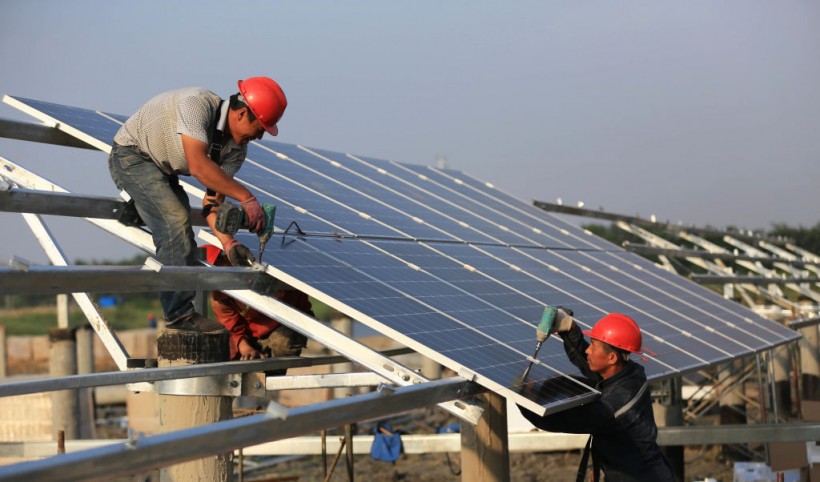Unlike NASA, which dropped the plan owing to its complexity and cost two decades ago, China is turning to space for solar energy.
South China Morning Post, citing UK-funded peer-reviewed research, said China plans to start construction on the first phase of a massive solar power project in 2028. A trial satellite orbiting the Earth at a distance of around 248 miles (400 kilometers) would be used to test the technology when the time comes.
The project will send energy from orbit back to Earth, possibly changing the way everyone in the world gets electricity.

Workers install solar panels at the construction site of 40MW photovoltaic on-grid power project of China Huaneng Group on June 11, 2018 in Huai an, China. The first phase with installed capacity of 30 megawatts will be put into operation at the end of June this year. (Photo by VCG/VCG via Getty Images)
How This Chinese 10-Megawatt Power Plant Beams Energy to Earth
Sky News said that satellites in geosynchronous orbit get sunshine for more than 99 percent of the time at a significantly higher intensity than solar panels on Earth.
According to the UK-funded report, the objective is to "gather this plentiful solar power in orbit and beam it securely to a fixed point" on Earth.
These beams might be sent to other countries "either as an energy export, as part of our foreign development aid, or to support humanitarian catastrophe situations," according to the researchers.
Unlike terrestrial renewable energy sources, orbiting solar power plants would be able to supply electricity at all hours of the day and night on Earth, regardless of the season or weather.
Professor Dong Shiwei, the Chinese paper's author, said per the same Sky News report that there are huge engineering obstacles that have yet to be overcome.
ALSO READ: China Embraces Space-Based Solar Power To Meet 2060 Carbon Neutral Target
Directing high-powered microwaves across vast distances would need a massive antenna - perhaps thousands of meters long - and might be hampered by solar winds, gravity, and satellite movement.
The proposal calls for the construction of a massive orbiting solar power space station in four phases. China would deploy a more robust plant to a geosynchronous orbit of 36,000 kilometers two years after the first test launch in 2030.
By 2035, the larger power plant would be able to distribute 10 megawatts to "select military and civilian customers," while the test station would have a 10 kilowatt power output.
By 2050, technology would have progressed sufficiently - and the station would be large enough - to allow for a power output of around two gigawatts, roughly similar to the output of most of the UK's terrestrial power reactors.
This would indicate that the outposts may be profitable.
About Space-Based Solar Power Plants
For the past several years, China has been actively pursuing the notion of space-based solar power plants. Digital Trends said the United States, Japan, the United Kingdom, India, and Russia have expressed interest in the same concept.
According to the article, NASA only said last month that it is looking into similar plans with the US. While the British government revealed earlier this year that it is considering a $20 billion proposal with several European defense contractors to put a pilot solar power plant in space by 2035, the British government revealed earlier this year that it is considering a $20 billion proposal with a number of European defense contractors to put a pilot solar power plant in space by 2035.
RELATED ARTICLE: Space-Based Solar Power Plant: UK Plans to Beam Energy From Space to Reach Goal of Zero Greenhouse Gas Emissions by 2035
Check out more news and information on Space-Based Solar Power in Science Times.














